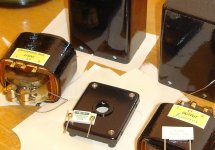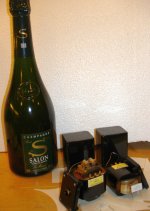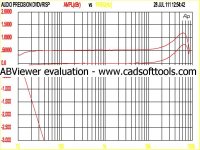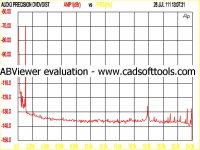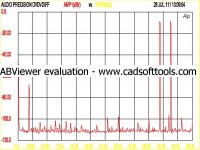They better be goooood!!! eBay - New & used electronics, cars, apparel, collectibles, sporting goods & more at low prices $1030.00 !!!
Please contact Bunpei for price. He is on this forum.
http://www.diyaudio.com/forums/members/bunpei.html
They are very, very good.
http://www.diyaudio.com/forums/members/bunpei.html
They are very, very good.
How much the IV transformer cost?
They better be goooood!!! eBay - New & used electronics, cars, apparel, collectibles, sporting goods & more at low prices $1030.00 !!!
Wow!!!
Current versus Voltage - a Transformer Compromise?
My experience with the Sabre DACs have mainly been with Oppo Players, the older BDP-83SE and now the newer BDP-95, ES9016 in the former and the ES9018 as in in Buffalo.
I have tried transformers but preferred the I/V approach. As Russ has stated, the 195R output Z means that the ideal load should be a near short or at least a very small fraction of 195R. No doubt that ESS sees Virtual Earth as the solution. I beg to differ, being somebody who wants and explores non-NFB solutions.
Based on what I hear and others have expressed, the transformer/voltage solution gives a lighter tonal balance, but nice and open.
To me, the I/V approach has a better tonal balance, but it requires some serious active circutry and associated power supplies. No wonder transformers look attractice.
But that lighter tonal balance... can something be done?
Something that retains the ease of transformer, yet puts some more body into the presentation.
Please look at the two examples below. It basically boils down to one or the other. You have to choose either Current or Voltage.
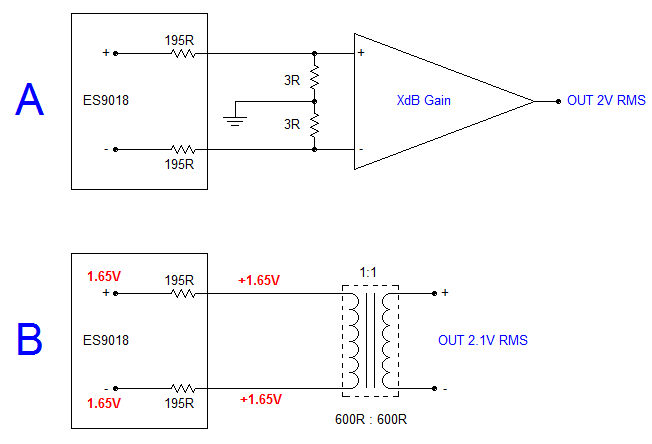
A: This represents my preferred way, using two very low value resistors straight to ground. They are a fraction of the value of 195R and so means we have avoided Virtual Earth but this doing it the current way.
But some may note this: There is a 1.65V offset voltage on the output of the DAC, but pulling that straight to ground we have exchanged offset voltage for offset current, the maths is simple:
1.65V/195R = 8.5mA
The beauty of this approach is that I can now make a differential direct-coupled non-NFB amplfier with suitable gain and get the expected 2V RMS output target.
Mind you, I am not one of those who gets nervous if falling short of 2V.
B: Don't you just look at the simplicity and from a DIY point of view, it is so attractive. Try different transformers, you don't need a engineering degree to experiment...
NOW TRY THIS:
 C:
C:
What you might call this, I don't know. It is not current I/V in the regular sense. But do note that we now have traded some of the offset voltage for current offset. Again the maths is simple, same as above:
1.65V/(195+330R) = 3.1mA
The offset voltage will be just above 1V DC. That DC will not go through the transformer, only AC current will be seen by the Primary. Looking AC wise, it also looks like a voltage divider:
(330R(195R+330R))*2.1VRMS = 1.3VRMS
But there is also another way of looking at it: The 3.1mA DC current offset is at least less that a tenth of the peak AC current required on the Secondary of the 1:1 transformer in pretty much all circumstances. The Sabre DAC is essentially modulating that current. Think of it as an iddle current being modulated.
Some kind of current processing is going on, but not in the sense of a proper I/V converter - which I still believe to be ideal, but maybe we are not looking for the ideal, just a better compromise for transformer use.
Bottom line, IF only 1.3V RMS output does not ruffle your feathers (it does some, but shouldn't), then like any good soup, how does it taste?
The general impression is that some of the missing sense of body comes back and very little that the transformer does so nicely is lost.
So guys, all it takes is a few resistors!!!
Some transformers will require a Zobel network on the secondary. I have tried my own QuadFilar transformers, they do not require a Zobel. But most others will. I have also tried another and less expensive transformer (my secret for now) that did require 10n/2K7 Zobel. I would recommend 600R:600R transformers, probably about 100R total DCR on Primary and Secondary. Also: That 330R resistor value can of course also be lowered (not much point increasing). But your output will go further down, but try it, maybe find a compromise that suits you.
How about this as another possibility: Use just 3R, as used in my I/V converter above, would give only 31mV RMS. Then you would need 50x gain amp on the Secondary, but it can be a single-ended circuit, ground one side of the Secondary, because the summing has already been done on the Primary. This could be done with tubes. Who said you couldn't do a proper I/V converter with tubes? With a 1:1 transformer you could.
For now, get some hands on four 330R resistors and tell the rest of us what you think, did you get a better tonal balance or anything else?
Cheers, Joe R.
My experience with the Sabre DACs have mainly been with Oppo Players, the older BDP-83SE and now the newer BDP-95, ES9016 in the former and the ES9018 as in in Buffalo.
I have tried transformers but preferred the I/V approach. As Russ has stated, the 195R output Z means that the ideal load should be a near short or at least a very small fraction of 195R. No doubt that ESS sees Virtual Earth as the solution. I beg to differ, being somebody who wants and explores non-NFB solutions.
Based on what I hear and others have expressed, the transformer/voltage solution gives a lighter tonal balance, but nice and open.
To me, the I/V approach has a better tonal balance, but it requires some serious active circutry and associated power supplies. No wonder transformers look attractice.
But that lighter tonal balance... can something be done?
Something that retains the ease of transformer, yet puts some more body into the presentation.
Please look at the two examples below. It basically boils down to one or the other. You have to choose either Current or Voltage.

A: This represents my preferred way, using two very low value resistors straight to ground. They are a fraction of the value of 195R and so means we have avoided Virtual Earth but this doing it the current way.
But some may note this: There is a 1.65V offset voltage on the output of the DAC, but pulling that straight to ground we have exchanged offset voltage for offset current, the maths is simple:
1.65V/195R = 8.5mA
The beauty of this approach is that I can now make a differential direct-coupled non-NFB amplfier with suitable gain and get the expected 2V RMS output target.
Mind you, I am not one of those who gets nervous if falling short of 2V.
B: Don't you just look at the simplicity and from a DIY point of view, it is so attractive. Try different transformers, you don't need a engineering degree to experiment...
NOW TRY THIS:

What you might call this, I don't know. It is not current I/V in the regular sense. But do note that we now have traded some of the offset voltage for current offset. Again the maths is simple, same as above:
1.65V/(195+330R) = 3.1mA
The offset voltage will be just above 1V DC. That DC will not go through the transformer, only AC current will be seen by the Primary. Looking AC wise, it also looks like a voltage divider:
(330R(195R+330R))*2.1VRMS = 1.3VRMS
But there is also another way of looking at it: The 3.1mA DC current offset is at least less that a tenth of the peak AC current required on the Secondary of the 1:1 transformer in pretty much all circumstances. The Sabre DAC is essentially modulating that current. Think of it as an iddle current being modulated.
Some kind of current processing is going on, but not in the sense of a proper I/V converter - which I still believe to be ideal, but maybe we are not looking for the ideal, just a better compromise for transformer use.
Bottom line, IF only 1.3V RMS output does not ruffle your feathers (it does some, but shouldn't), then like any good soup, how does it taste?
The general impression is that some of the missing sense of body comes back and very little that the transformer does so nicely is lost.
So guys, all it takes is a few resistors!!!
Some transformers will require a Zobel network on the secondary. I have tried my own QuadFilar transformers, they do not require a Zobel. But most others will. I have also tried another and less expensive transformer (my secret for now) that did require 10n/2K7 Zobel. I would recommend 600R:600R transformers, probably about 100R total DCR on Primary and Secondary. Also: That 330R resistor value can of course also be lowered (not much point increasing). But your output will go further down, but try it, maybe find a compromise that suits you.
How about this as another possibility: Use just 3R, as used in my I/V converter above, would give only 31mV RMS. Then you would need 50x gain amp on the Secondary, but it can be a single-ended circuit, ground one side of the Secondary, because the summing has already been done on the Primary. This could be done with tubes. Who said you couldn't do a proper I/V converter with tubes? With a 1:1 transformer you could.
For now, get some hands on four 330R resistors and tell the rest of us what you think, did you get a better tonal balance or anything else?
Cheers, Joe R.
Last edited:
Offering of free evaluation opportunity in EU region
To staccatiss,
We much appreciated your detailed and complete review on Feastrex line transformer specially developed for ES9018 DAC.
The designer and manufacturer of the transformer intend to provide a better product by employing an innovative core material than those conventional ones in the market.
However, actual listening is believing.
The Feastrex company offers an opportunity for some audiophiles in EU region to evaluate the pair. Please send an usual e-mail ( NOT a private messaging of this forum) to my following address;
bunpei<at>ta2<do>so-net<dot>ne<jp>,
if you are interested in the evaluation.
"staccatiss" in Sweden will forward the pair to you. We may require a certain evidence information that identifies you and ensures your trustworthiness.
After your two or three week evaluation period, we request your shipment to the next evaluator in EU region or send back to Feastrex compnay in Japan with your expense. When you want to buy the pair after your evaluation, a discounted price can be expected.
Bunpei
To staccatiss,
We much appreciated your detailed and complete review on Feastrex line transformer specially developed for ES9018 DAC.
The designer and manufacturer of the transformer intend to provide a better product by employing an innovative core material than those conventional ones in the market.
However, actual listening is believing.
The Feastrex company offers an opportunity for some audiophiles in EU region to evaluate the pair. Please send an usual e-mail ( NOT a private messaging of this forum) to my following address;
bunpei<at>ta2<do>so-net<dot>ne<jp>,
if you are interested in the evaluation.
"staccatiss" in Sweden will forward the pair to you. We may require a certain evidence information that identifies you and ensures your trustworthiness.
After your two or three week evaluation period, we request your shipment to the next evaluator in EU region or send back to Feastrex compnay in Japan with your expense. When you want to buy the pair after your evaluation, a discounted price can be expected.
Bunpei
Hi Bunpei,
Any chance of circulating that Transformer to the U.S for evaluation?
Thanks,
Joe
Hello Joe,
I will look into a way with Bunpei and Feastrex Japan.
Kenji@Audio Feast (Nashville TN)
Just thought I'd add this:

This is proper I/V Converter. The input to the Tube Stage will see no DC - a variety of tube circuits could be used, but decent gain, low noise, are minimum requirements.
Cheers, Joe R.
Hello Joe
Newbie question
Each output (+ , -) can sink or source the signal ....
So why the center 3R connected to ground ?
What's the value of the current from +- to Gnd ?
Thanks!
Richard
Hello Joe
Newbie question
Each output (+ , -) can sink or source the signal ....
So why the center 3R connected to ground ?
What's the value of the current from +- to Gnd ?
Thanks!
Richard
Hi Richard
The idea is to achive current mode.
The otput of the DAC needs to see only a small fraction of it 195 Ohm output impedance otherwise it will not be working "current" mode.
If you don't ground, you would have a single 6R and it would be in voltage mode and most of the two phases would cancel out and you'd get 30mV RMS approx. Just no point doing it that way.
Note that internal 1.65V offset, the Sabre DAC is unique in that you can still ground it to 0V (don't try this with any other current DAC - it may not survive - and don't do it to conventional voltage DACs since they all have about 2.5V). So essentially shorting the output to virtually ZERO Volt, means the offset now become a current offset of 8mA.
But getting a high ratio 193R/3R = 65 - is the only way to get current mode.
Other than that, the suggested idea is pretty straight forward.
Much simpler to use twin 330R as suggested with 1:1 transformer, even if the fancy Japanese kind exotic transformer.
Cheers, Joe R.
Last edited:
I will look into a way with Bunpei and Feastrex Japan.
Dear joemana,
Please send your PM to "fulken".
He may arrange an opportunity for you in U.S.
Bunpei
Feastrex Urushi coated finemet transformer, brief impression
Mr. Yukihito of Feastrex Japan kindly allowed me to borrow a pair of their Finemet transformer "FLT-ES1" (designed mainly for ES9018DAC).
I had installed them directly to BII's output and listened last week.
That's my first experience of transformer output stage, so I have no idea how they are sonically superior/inferior to the other trafos.
I usually have used discrete opamp I/V stage designed by Mr. Fujiwara, that's highly regarded among Japanese DIY people.
(That I/V stage is originally designed for pcm1794, but I think works well with other high current output dacs like ES9018 in 2ch stereo mode)
Compared to discrete opamp, the Finemet transformer has less bass dynamics and less wide soundstage,
however I feel those "degradations" are not so audible and better than I expected.
I think some people might prefer other active I/V stages such as Legato in this regard.
Each instruments, Voices are somewhat more naturally presented and detailed, and have better textures with Finemet transformers.
e.g. - I felt I could realize each notes much easier, especially with mixed choruses.
Besides, as Mr. Yukihito mentioned in his blog, metalic percussions - especially symbals - are most realistic and enjoyable without being harsh.
Mr. Yukihito explained in e-mail, their transformer filters HF noises out of audio band very well, so can reproduce these "realistic" HF characteristics,
however this cause some people might feel somewhat earlier HF roll off. I felt these "roll off" are totally acceptable for me, but some might prefer "brighter" "more opened" HF characteristics.
I think that's a matter of taste.
That's my humble impression of BuffaloII + "FLT-ES1". I decided to ordered one pair of them after the loan period...
Mr. Yukihito of Feastrex Japan kindly allowed me to borrow a pair of their Finemet transformer "FLT-ES1" (designed mainly for ES9018DAC).
I had installed them directly to BII's output and listened last week.
That's my first experience of transformer output stage, so I have no idea how they are sonically superior/inferior to the other trafos.
I usually have used discrete opamp I/V stage designed by Mr. Fujiwara, that's highly regarded among Japanese DIY people.
(That I/V stage is originally designed for pcm1794, but I think works well with other high current output dacs like ES9018 in 2ch stereo mode)
Compared to discrete opamp, the Finemet transformer has less bass dynamics and less wide soundstage,
however I feel those "degradations" are not so audible and better than I expected.
I think some people might prefer other active I/V stages such as Legato in this regard.
Each instruments, Voices are somewhat more naturally presented and detailed, and have better textures with Finemet transformers.
e.g. - I felt I could realize each notes much easier, especially with mixed choruses.
Besides, as Mr. Yukihito mentioned in his blog, metalic percussions - especially symbals - are most realistic and enjoyable without being harsh.
Mr. Yukihito explained in e-mail, their transformer filters HF noises out of audio band very well, so can reproduce these "realistic" HF characteristics,
however this cause some people might feel somewhat earlier HF roll off. I felt these "roll off" are totally acceptable for me, but some might prefer "brighter" "more opened" HF characteristics.
I think that's a matter of taste.
That's my humble impression of BuffaloII + "FLT-ES1". I decided to ordered one pair of them after the loan period...
Interesting post, Wktk_smile-san.
I actually have the impression that the feastrex transformers+TX2352+10nF PS load have more energy in the trble than the Legato.
Could you tell us a bit more about how you loaded the transformer?
Where can I find Mr. Yukihito´s blog?
BTW,
I ordered an urushi-coated pair of Feasterex transformers and they arrived a -few days ago. Attached are some photos.
I am now awaiting some 10nF Teflon and tin foil caps from Percy Audio and cryo treated mono crystalline copper wire. Then, I will hook everything up to my B2.
The champagne I have to sell to finance the transformers...
I actually have the impression that the feastrex transformers+TX2352+10nF PS load have more energy in the trble than the Legato.
Could you tell us a bit more about how you loaded the transformer?
Where can I find Mr. Yukihito´s blog?
BTW,
I ordered an urushi-coated pair of Feasterex transformers and they arrived a -few days ago. Attached are some photos.
I am now awaiting some 10nF Teflon and tin foil caps from Percy Audio and cryo treated mono crystalline copper wire. Then, I will hook everything up to my B2.
The champagne I have to sell to finance the transformers...
Mr. Yukihito of Feastrex Japan kindly allowed me to borrow a pair of their Finemet transformer "FLT-ES1" (designed mainly for ES9018DAC).
I had installed them directly to BII's output and listened last week.
That's my first experience of transformer output stage, so I have no idea how they are sonically superior/inferior to the other trafos.
I usually have used discrete opamp I/V stage designed by Mr. Fujiwara, that's highly regarded among Japanese DIY people.
(That I/V stage is originally designed for pcm1794, but I think works well with other high current output dacs like ES9018 in 2ch stereo mode)
Compared to discrete opamp, the Finemet transformer has less bass dynamics and less wide soundstage,
however I feel those "degradations" are not so audible and better than I expected.
I think some people might prefer other active I/V stages such as Legato in this regard.
Each instruments, Voices are somewhat more naturally presented and detailed, and have better textures with Finemet transformers.
e.g. - I felt I could realize each notes much easier, especially with mixed choruses.
Besides, as Mr. Yukihito mentioned in his blog, metalic percussions - especially symbals - are most realistic and enjoyable without being harsh.
Mr. Yukihito explained in e-mail, their transformer filters HF noises out of audio band very well, so can reproduce these "realistic" HF characteristics,
however this cause some people might feel somewhat earlier HF roll off. I felt these "roll off" are totally acceptable for me, but some might prefer "brighter" "more opened" HF characteristics.
I think that's a matter of taste.
That's my humble impression of BuffaloII + "FLT-ES1". I decided to ordered one pair of them after the loan period...
Attachments
Hi, staccatiss,
I had simply inserted load resistor in secondary as their recommendation.
I used 2.4k ohm generic metal film I just found in my junkbox.
I felt "brightness" in treble decreased with Finemet transformer in comparison to previously used I/V stage. That's not always, but with some recordings.
Later I realized this kind of brighter treble of previously used discrete op amp I/V tend to have fogginess - this actually masked details in some extent - at the same time.
Here's related article in Mr. Yukihito's blog. (in Japanese only)
Feastrex????????????????? | SD????????????????
Cheers,
I had simply inserted load resistor in secondary as their recommendation.
I used 2.4k ohm generic metal film I just found in my junkbox.
I felt "brightness" in treble decreased with Finemet transformer in comparison to previously used I/V stage. That's not always, but with some recordings.
Later I realized this kind of brighter treble of previously used discrete op amp I/V tend to have fogginess - this actually masked details in some extent - at the same time.
Here's related article in Mr. Yukihito's blog. (in Japanese only)
Feastrex????????????????? | SD????????????????
Cheers,
One very good solution, in my opinion, is to use the 3575 OCC from Sowter (http://www.sowter.co.uk/pdf/3575.pdf); it is 1:1.
I use the output from buffalo to feed a 15 ohm resistor (current mode) for + and -.
Then I connect each end of the primary, and the center to ground.
On secondary I put a 3k3 or 4k7 ohm in palallel, unbalanced mode, then a CF of 6922, tube power supply with a good filtering.
Trimming this resistor I can change the frequency response with a little change on signal amplitude.
In attach you can find a frequency response with a 24bit/192Khz come from a AP x585; the ressitor on secondary is 10k , I got 0,7 db of increment at 70 kHz.
With 4k7 I got -1 db about 40Kz, also good for signal at 24/192Khz.
The S192_70, is a signal 1 Khz, -70 db 24bit/192Khz; good performance
The S96_diff is a test, 24/96Kh,z with two signal at 40Khz and 44KHz, also in this case a good perf.
This before a little modification on tube power supply to have a better residual noise.
Bye
Walter
I use the output from buffalo to feed a 15 ohm resistor (current mode) for + and -.
Then I connect each end of the primary, and the center to ground.
On secondary I put a 3k3 or 4k7 ohm in palallel, unbalanced mode, then a CF of 6922, tube power supply with a good filtering.
Trimming this resistor I can change the frequency response with a little change on signal amplitude.
In attach you can find a frequency response with a 24bit/192Khz come from a AP x585; the ressitor on secondary is 10k , I got 0,7 db of increment at 70 kHz.
With 4k7 I got -1 db about 40Kz, also good for signal at 24/192Khz.
The S192_70, is a signal 1 Khz, -70 db 24bit/192Khz; good performance
The S96_diff is a test, 24/96Kh,z with two signal at 40Khz and 44KHz, also in this case a good perf.
This before a little modification on tube power supply to have a better residual noise.
Bye
Walter
Attachments
- Status
- This old topic is closed. If you want to reopen this topic, contact a moderator using the "Report Post" button.
- Home
- More Vendors...
- Twisted Pear
- Buffalo II & transformers

